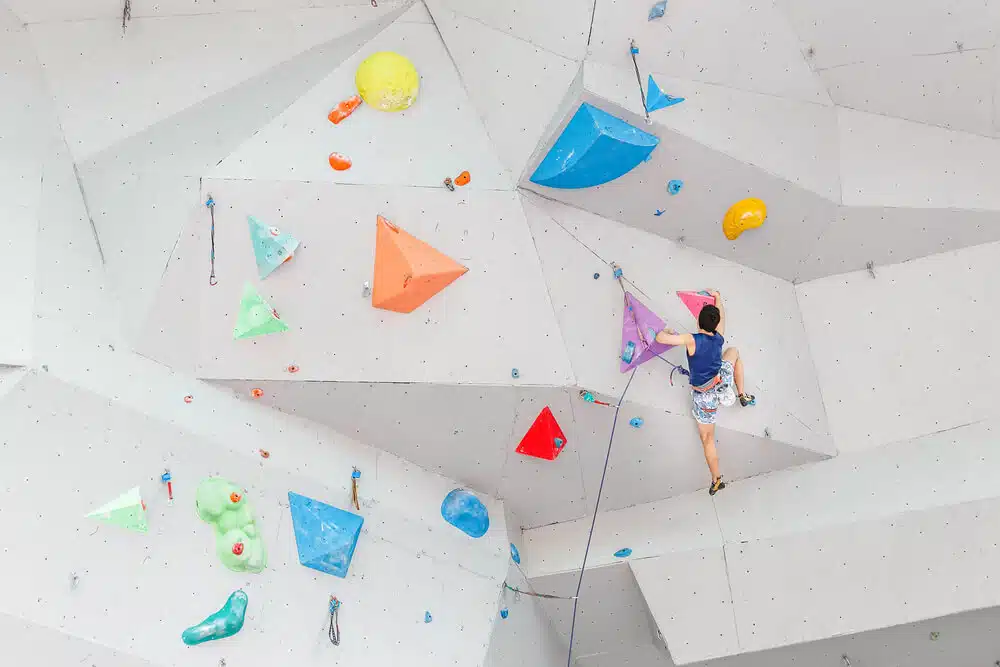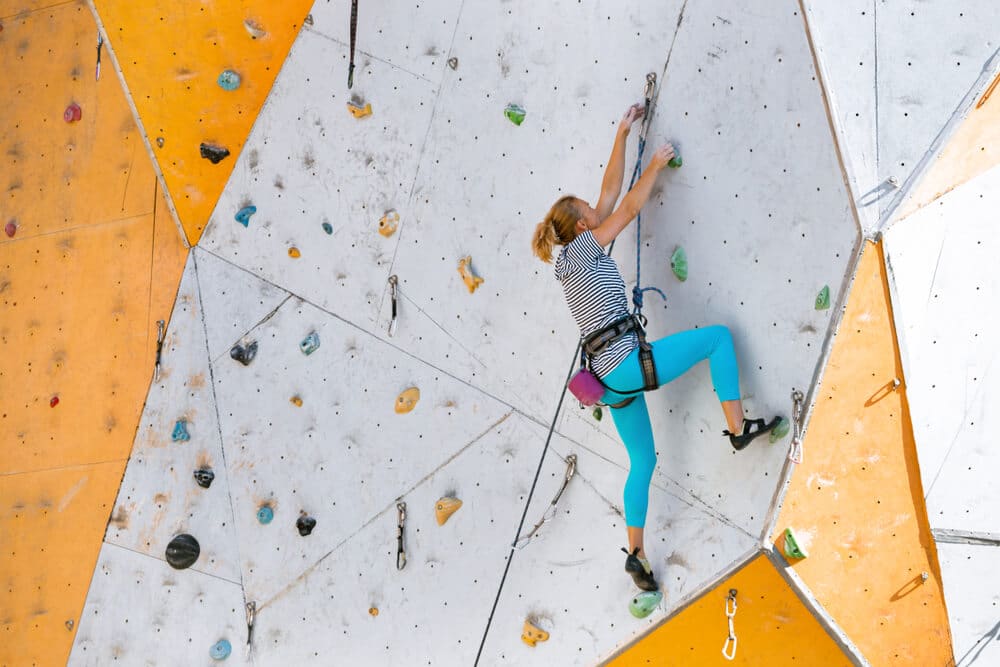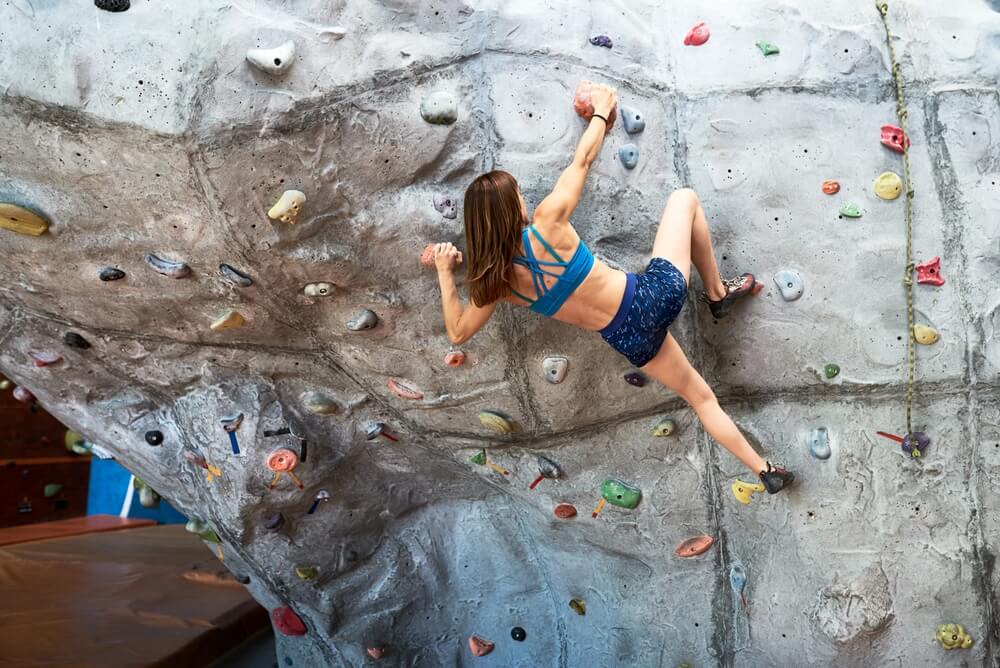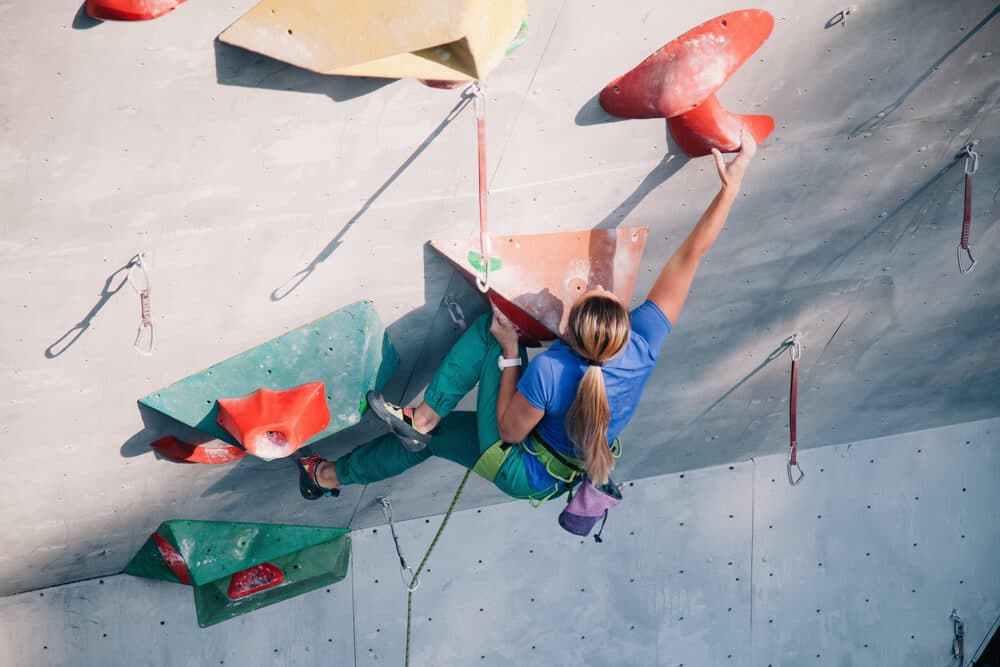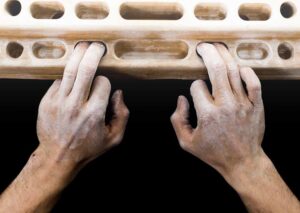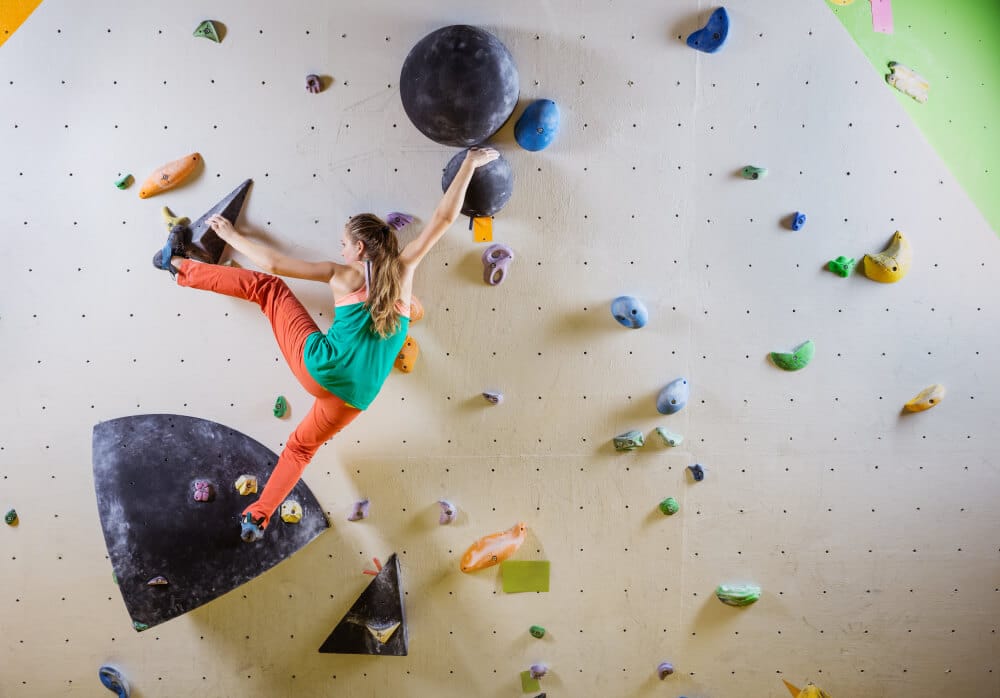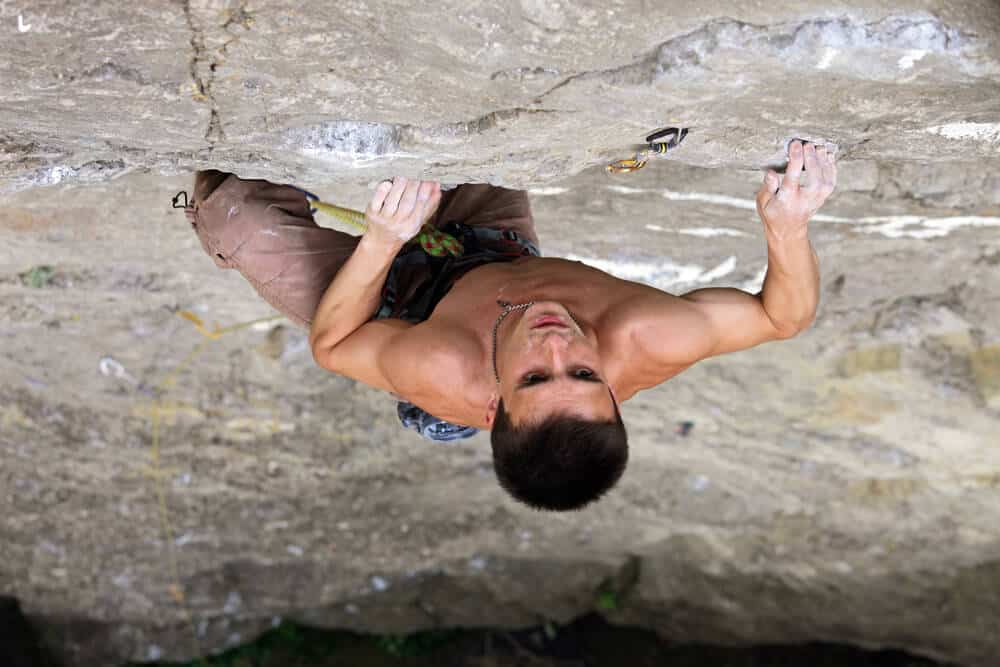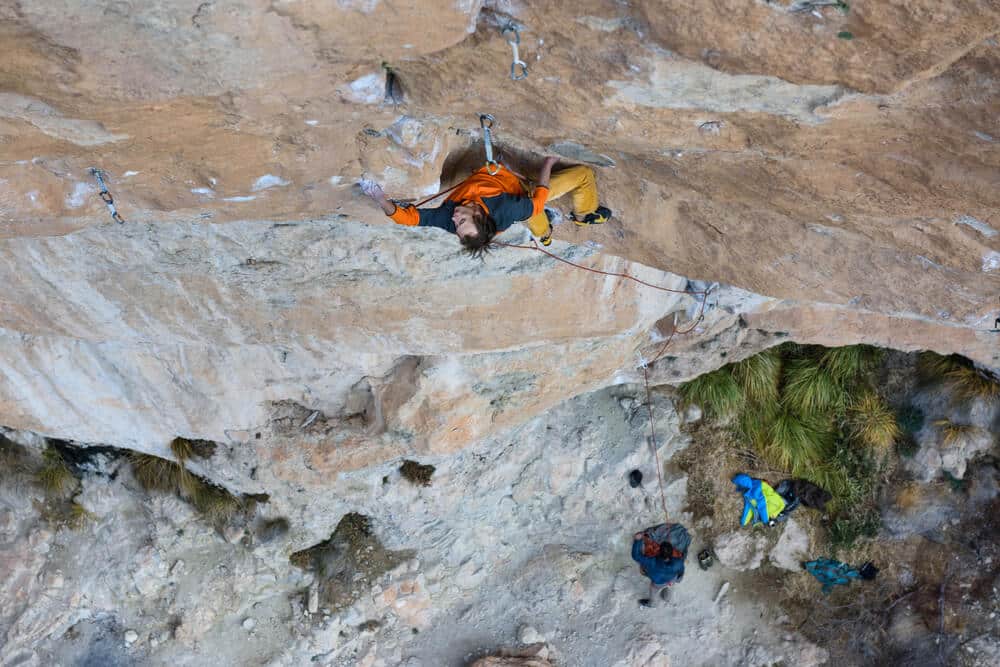Once you’ve been climbing for a little while, you may start feeling a plateau, as though you’ve reached a point where simply climbing a lot isn’t enough to continue your progress. This could happen after a few weeks of regular climbing or after six months (more likely the latter). Either way, that probably means it’s time to start considering training for climbing.
Climbing training can be broken down into many disciplines, such as stamina, strength, technique, and even mental game. Another of those disciplines, and one of the most important, is endurance.
In this article, we’ll learn what endurance training is in climbing, how to train endurance in climbing, offer a few tips and tricks, and then answer some frequently asked questions about climbing endurance training.
What is Endurance Training in Climbing? Endurance vs. Power Endurance Training
To start, we have to understand what “endurance” means in climbing, because there are a few different connotations. The two most common subcategories of endurance training are standard endurance training and what’s called “power endurance” training.
Normal endurance is the ability to climb at a sub-maximal strength (meaning moderate or easy level) for a “long” period of time. It’s basically high volume, low intensity. An example of this could be doing repeated burns on long, easy routes, climbs that are two or three grades below your projecting grade.
On the other hand, power endurance (also known as strength endurance) is low volume, high intensity. It’s about being able to climb a hard route or boulder problem and continue to put out high levels of strength and power throughout the entire climb. (We’re talking sustained climbing around 15 and 40 moves.)
Another way of thinking of the difference is that pure endurance is a 20-minute run, while power endurance is a 2-minute sprint. The former is primarily testing your aerobic capacity, while the latter is primarily anaerobic. We can think of endurance as aerobic endurance, and power endurance as anaerobic endurance.
How Do I Train Endurance?
Sport Endurance Sessions
The easiest way to train endurance while lead or top rope climbing, is through long, continuous sessions of low-intensity climbing. That means lapping climbs that are two to three grades below your projecting grade, over and over and over.
A sample session could involve three route sets (i.e. climbing three routes back-to-back) and resting after each set. In between routes, try to lower and hop on the next line as quickly as possible, with little to no pause. Complete five sets in total. Choose routes with good, large holds, a near-vertical wall angle, and easy sequences, like big moves between jugs.
Another way to train endurance when rope climbing is to do double takes on the wall. Climb up the wall like normal and then down climb instead of lowering. You can do this on sport outside, or on top rope or an auto belay in the gym. Again, focus on easy routes with basic movements and large holds, at least to start off. Avoid overly technical sequences.
With both training regimes, aim to increase difficulty gradually as you progress, but remember that the focus is on endurance, not difficulty.
Bouldering Endurance Sessions
Training endurance when bouldering is similar to what we’d do for roped endurance.
You want to focus on staying on the bouldering wall and climbing for as long as possible. Traversing the boulder wall, or doing up-down sessions on an easy, low-angle section of the boulder wall, is a great way to do this. Aim for a moderate and continuous level of pump. If you get pumped out, instead of hopping off the wall, find a juggy rest and try to recover on the wall before climbing more.
Remember to be respectful of others while performing high volume bouldering wall training. Avoid traversing and staying on the way for an extremely long time if the gym is crowded and there are others nearby who might like to hop on the wall.
Instead of bulk long sessions, another way to train endurance that can be more conducive if the gym is crowded is to have on/off swaps. Increase time on and off the wall as you work. For example, in the first session, do five minutes of climbing on the wall, then five off. Then 10 minutes on the wall and 10 minutes off, then 15 minutes on and 15 off. After that, cycle back down to 10 minutes on, 10 off, then five on, five off.
You can also climb problems normally, but do them in pyramid formation. For example, climb four V0s, then three V1s, then two V2s, and one V3. Then two V2s, three V1s, and four V0s again. (These difficulties may not be right for you, just ensure that the hardest problem, the one at the top of the pyramid, takes you about three or four attempts.)
Rest between each set of problems, and try to increase the volume for the harder climbs as you improve and become more comfortable with the workout.
How Do I Train Power Endurance?
Power Endurance Sport Climbing
Now that we’ve talked about training normal endurance, let’s look at power endurance.
One way to do this while roped climbing in climbing gyms is to do 6x2s.
Find two routes of the same grade that you can climb consecutively. Again, look for a route that’s two or three grades below your project grade. Climb both routes back to back, resting only after the second route, and resting for a time equal to your climbing time. Do these double sets six times.
Try to complete at least the first four or five sets without falling. It’s okay to fall on the fifth or sixth. Once you’re comfortable with this method, you can also try to use a selection of different routes rather than the same two. Increase the difficulty gradually. On your second or third session, you could make the first route a grade harder and then make the second route harder.
Another way to train power endurance is to do 8x1s.
Instead of doing two easy routes back to back six times, do one eight individual (slightly harder) routes in a row. instead of choosing routes that are two or three grades below your max onsight level, go with routes that are only one grade below. Again, rest in between each climb for a period of time equal to climbing time (the time you’re on the wall).
Power Endurance Bouldering
For bouldering, there are a couple of different workouts we can use to boost power in endurance.
One is 4x6s.
Choose four different boulder problems that are around the same grade and style. These should be problems that you can climb in a row, back to back.
Choose problems around one grade below your flash grade. After each four-problem set, rest for eight minutes. Repeat this six times. Like with our other workouts, you can make your sessions slightly harder each time by gradually choosing harder problems.
A second workout doesn’t revolve around specific problems but around completing a 30-move circuit. Choose a circuit of around 25 to 30 moves on a bouldering wall. You can choose whatever movements you want, but they should be multi-directional, with upward, downward, and diagonal climbing, as well as lateral traversing, and always finish with traditional vertical climbing.
If you’re having trouble finding a good sequence, you can simply link together a few set, color-coded boulder problems by climbing up one and down the next, then repeat.
Whatever you choose, avoid hard single cruxes or good rest positions. Aim for sustained, continuous moderate sequences. Do this 30-move circuit six times in a row, with eight minutes of rest in between, like in the previous exercise.
5 Tips for Improving Endurance On the Wall
1. Incorporate Interval Training
Interval training is a potent method for boosting climbing endurance. By alternating between periods of intense climbing and rest, you can significantly improve your ability to sustain effort over longer climbs.
Start with shorter intervals of hard climbing followed by brief rests, gradually increasing the climbing time and decreasing the rest period. This mimics the demands of difficult routes, teaching your body to recover more quickly and efficiently. Incorporate this into your routine once or twice a week.
2. Practice on Longer Routes
Endurance isn’t just about physical capacity, but mental stamina. Climbing longer routes or boulders trains your mind and body to handle the sustained effort required for extended climbs. If your usual practice involves shorter routes, integrate longer ones into your sessions. Focus on maintaining a steady pace and using efficient movements.
This practice will help you develop a rhythm, enhancing your ability to climb more prolonged sections without tiring quickly and teaching your body to economize energy.
3. Utilize Rest Positions
Learning to find and utilize rest positions won’t directly improve your endurance, but it will improve your performance on long routes.
Efficiently resting while climbing allows your muscles to recover, reducing fatigue. Practice identifying potential rest spots on your climbs, such as places where you can shift your weight off your arms or use a knee bar. In particular, a focus on proper footwork will allow you to find and access more rest positions.
Spend time during your sessions working on relaxing in these positions, even when you don’t feel tired. This skill will be invaluable for longer climbs, where strategic resting can make the difference between reaching the top or burning out too soon.
4. Focus on Breathing Techniques
Breathing plays a critical role in endurance. Proper breathing helps maintain oxygen flow to your muscles, delaying the onset of fatigue. Practice deep, rhythmic breathing both during your climbs and as part of your training routine.
Concentrate on inhaling and exhaling fully, especially during difficult sections of a climb or when resting. This can help lower your heart rate, relax your muscles, and improve your overall endurance. Integrating focused breathing exercises into your training can enhance your ability to stay calm and endure through challenging sections.
5. Increase Core Strength
A strong core is fundamental for climbing efficiency and endurance. Your core muscles support your body on the wall, reducing the load on your arms and legs, and allowing for better energy conservation.
Incorporate specific core workouts into your training regimen, focusing on exercises that mimic climbing movements, such as planks, leg raises, and twisted sit-ups. A robust core enables better body positioning and movement efficiency, which translates to less energy expended on each move.
Frequently Asked Questions
What can different goals of endurance training be?
Training endurance in climbing can target different goals. One key goal is to increase the ability to sustain effort over longer climbing routes, enhancing overall stamina for multi-pitch or longer single-pitch climbs. This is traditional endurance, the sort of thing needed for roped climbing.
Another goal might focus on improving power endurance, which allows climbers to execute tight sequences of difficult moves without pumping out. This would be ideal for hard, steep sport climbing and bouldering.
Some climbers also aim to boost their recovery speed between climbs or difficult sections within a route, enabling more efficient rest and reduced fatigue. Lastly, you could also have a goal of improving mental stamina, maintaining focus and determination through challenging sections or long days on the wall.
Can you lose strength or power when working only on endurance?
Yes, focusing solely on endurance can lead to a decrease in strength or power, a phenomenon known as the “interference effect.” This occurs because endurance and strength training promote different and somewhat conflicting adaptations within the body.
Climbing endurance training optimizes the body for prolonged activity at lower intensity, enhancing aerobic capacity and muscle efficiency at the expense of maximal strength and power output. Consequently, if a climber’s training cycle overemphasizes endurance without incorporating sufficient strength or power training, the climber may experience a reduction in their ability to perform short bursts of intense activity. See below.
Should you also do strength training at the same time as training endurance?
Your training cycle should incorporate both endurance and strength training. Incorporating strength training alongside endurance is an effective strategy for climbers seeking comprehensive fitness improvements. This approach, properly structured, can help climbers achieve a balance between strength, power, and endurance, which are all critical for climbing performance. There are two ways to do this, either via concurrent training or undulating periodization.
Concurrent Training involves combining strength and endurance in the same training cycle. This method can lead to improved overall fitness, as it allows climbers to work endurance while maintaining (or even gaining) strength and power. The key to successful concurrent training is careful planning to minimize the interference effect, so training endurance doesn’t hinder strength gains. Strategies include scheduling strength and endurance sessions on separate days or separating them by several hours if done on the same day, prioritizing strength training when fresh.
Undulating Periodization is another effective approach. Instead of combining training, you’ll vary the volume and intensity of your workouts either weekly or daily, and swap focuses, alternating between prioritizing different aspects like strength, power, and endurance. This variation helps achieve a balance between different fitness components, but also reduces the risk of overtraining and injury by preventing monotony and allowing better recovery.
Both methods have merits and can be tailored to individual needs and goals. For climbers, incorporating elements of both strategies is most beneficial. You could try to train concurrently for one cycle, then the next cycle swap between focusing on power, endurance, and strength.


